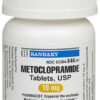Medication Overview: Metoclopramide
Metoclopramide is a medication commonly used to treat nausea and vomiting associated with certain medical conditions such as gastroesophageal reflux disease (GERD), gastroparesis, and chemotherapy-induced nausea. The drug functions primarily as a dopamine receptor antagonist, which helps increase gastrointestinal motility and accelerate stomach emptying. It may be administered orally in tablet form, as a liquid solution, or via injection in a clinical setting. Understanding its mechanism of action, dosage guidelines, and potential interactions is critical for safe and effective use.
Mechanism of Action: Dopamine Antagonism
Metoclopramide works by blocking dopamine receptors in the chemoreceptor trigger zone of the central nervous system. This action aids in reducing the sensation of nausea and vomiting. Additionally, metoclopramide promotes the release of acetylcholine in the upper gastrointestinal tract, enhancing gastric motility and expediting gastric emptying. The dual action on both the central and peripheral systems results in a decreased likelihood of nausea and improved digestive health.
Pharmacokinetics: Absorption and Distribution
The medication is absorbed rapidly when administered orally, with peak plasma concentrations typically occurring within one to two hours. Metoclopramide crosses the blood-brain barrier, leading to its central nervous system effects. It is also distributed widely throughout the body tissues. Its bioavailability can be affected by factors such as liver function, as the drug undergoes hepatic metabolism. Understanding these pharmacokinetic properties is essential for optimizing therapeutic efficacy and minimizing adverse reactions.
Common Dosage Forms
Metoclopramide is available in several dosage forms, including 5 mg and 10 mg tablets, as well as oral liquid solutions with concentrations commonly at 5 mg/5 mL. Injectable forms provide healthcare providers with options for intravenous or intramuscular administration, particularly useful in acute care settings. The choice of formulation can depend on the clinical scenario, patient preference, and tolerability, highlighting the importance of appropriate formulation selection for achieving optimal patient outcomes.
Indications: Approved Uses
The primary indications for metoclopramide include the management of diabetic gastroparesis and the suppression of nausea and vomiting linked to chemotherapy, surgery, or various gastrointestinal disorders. Metoclopramide may also be prescribed off-label for conditions such as chronic migraines and certain dyspepsia syndromes. It is essential that usage conforms to the guidance of clinical protocols, adjusting for individual patient needs and ensuring continuous monitoring for therapeutic effectiveness.
Administration Guidelines
When administered orally, metoclopramide should ideally be taken 30 minutes before meals and at bedtime to maximize its prokinetic effects. Treatment duration varies based on the indication but should generally not exceed 12 weeks due to risk of adverse effects associated with long-term use. Intravenous or intramuscular administration typically occurs in a medical setting, often involving direct professional supervision to monitor immediate drug effects and patient response.
Potential Drug Interactions
Metoclopramide can interact with various medications, altering their effects. For instance, concurrent use with anticholinergic agents may reduce the prokinetic efficacy of metoclopramide. It may potentiate the effects of CNS depressants such as sedatives and alcohol, heightening the risk of increased drowsiness or sedation. Additionally, metoclopramide can influence the plasma levels of drugs like digoxin, necessitating close monitoring of therapeutic drug levels and potential dose adjustments.
Adverse Effects: Common Reactions
Patients taking metoclopramide may experience a range of side effects, with the most frequent being fatigue, dizziness, and headache. Extrapyramidal symptoms, such as involuntary muscle movements and tremors, also pose a significant concern, particularly with long-term use or higher dosages. Gastrointestinal disturbances, including diarrhea and abdominal discomfort, have also been reported. Patient education on recognizing these adverse effects is vital in ensuring early detection and management.
Special Considerations: Pediatrics and Elderly
The use of metoclopramide in pediatric patients requires careful consideration due to heightened susceptibility to extrapyramidal reactions. Dosage adjustments based on weight and age are essential to ensure safety. Elderly patients may also require dosage modifications and closer monitoring given their increased risk for sedation, confusion, and drug accumulation due to reduced renal function. Tailoring therapy to account for age-related factors will help mitigate risks associated with medication use in these populations.
Monitoring: Regular Assessments
Regular monitoring is a pivotal component of metoclopramide therapy, focusing on observing efficacy in symptom relief and identifying any adverse reactions. In cases with prolonged use, assessing for tardive dyskinesia symptoms is crucial as this represents a significant medication-related risk. Periodic liver function tests and renal assessments can also be valuable, particularly in patients with pre-existing organ concerns, ensuring that the medication regimen is both safe and effective.
Patient Counseling Points
Providing patients comprehensive counsel on proper drug use is critical. Advise them on adhering to dosing schedules and avoiding activities requiring alertness if drowsiness occurs. Highlight interactions with alcohol and other CNS depressants and the importance of reporting any involuntary movements or neurologic symptoms promptly. Utilizing feedback from patient experiences can also enhance ongoing therapy management by aligning clinical decisions with individual patient responses and preferences.
Storage and Handling Requirements
Metoclopramide should be stored at room temperature, away from moisture and direct light to maintain its stability and potency. Liquid formulations should be measured accurately using an appropriate measuring device. For healthcare providers, ensuring injectables are stored as per manufacturer guidelines is vital to preserving their efficacy. Proper disposal of any medication no longer needed should be in accordance with safety standards to prevent accidental misuse or environmental harm.
Conclusion: Professional Usage Importance
Metoclopramide requires careful administration and monitoring to deliver therapeutic benefits effectively for treating nausea and various gastrointestinal disorders. Comprehensive understanding of its pharmacokinetics, interaction potential, and side effect profile is crucial for healthcare professionals. Customized patient education, vigilant monitoring, and individualized therapy adjustments enable the optimization of patient outcomes while minimizing the risk of adverse effects.








Reviews
There are no reviews yet.